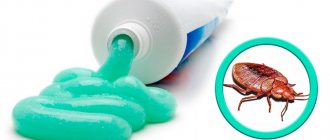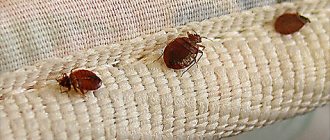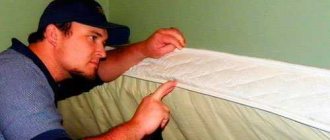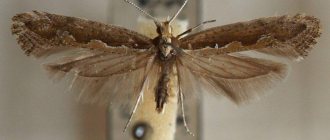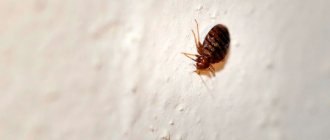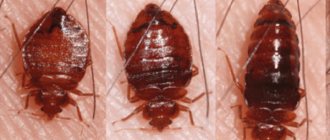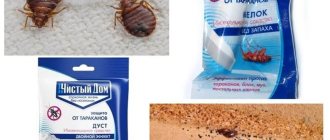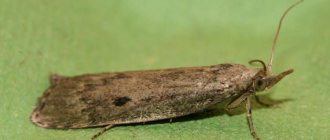Many people wonder how to prevent the appearance of bedbugs in an apartment once and for all? The difficulty lies in the fact that feeding exclusively on the blood of animals and humans, the female bug is capable of reproduction; she scatters eggs over long distances, which contributes to the spread of mature larvae throughout the entire area of the room.
If access to blood is blocked, the female is able to fall into suspended animation and remain in this state until favorable conditions are created around her for the continuation of life.
Main rules of prevention
Before you begin preventive measures against blood-sucking insects, you need to find out how bedbugs enter the room, and then try to block them.
You should also understand that if there is even a minimal threat of an apartment being attacked by bloodsuckers, sooner or later this will happen.
There are several ways parasites can enter:
- Electrical sockets. Small parasites easily penetrate through narrow passages from one apartment to another. If your neighbors decide to kill bedbugs, whole colonies of insects will immediately begin to migrate through the smallest cracks in the wall separating your apartment from the neighbor’s. If there is a gap between the outlet and the wall, it should be covered with alabaster or injected into it with non-flammable foam or other material blocking the path.
- Ventilation riser shaft. During persecution or prolonged unfavorable conditions for the life of parasites (lack of a power source, uncomfortable ambient temperature), bedbugs move along the common building riser in search of comfortable living conditions, breeding from apartment to apartment. To prevent bedbugs in an apartment, the standard ventilation shaft grille can be replaced with a fine mesh.
- Ceiling and floor cracks are also ways for bloodsuckers to penetrate. Since both adults and larvae are flat in shape, they can penetrate the narrowest crevices. Therefore, for the purpose of prevention, you should carefully cover up all defects in the apartment with a special building mixture.
- Window coverings, doors. An adult is able to get from the window of one apartment to the next one in an average of half an hour. For safety reasons, it is recommended to install plastic windows with a reliable rubber seal.
- Furniture and household appliances can become a haven, a breeding ground for bloodsuckers. Often, entire colonies of bedbugs are found in computer system units, televisions, and other household devices. For preventive purposes, you should carefully inspect furniture and things for the presence of bloodsuckers, especially if they were purchased second-hand.
- Clothes, shoes and accessories can also cause an apartment to be infested if they were previously in closets infested with insects.
Understanding how bedbugs can get into an apartment, the rules for necessary preventive measures become obvious.
.To prevent the invasion of blood-sucking parasites into the apartment, it is recommended to follow the following instructions:
- To avoid the appearance of bedbugs, you should carry out cosmetic repairs in the apartment (replace the flooring, seal cracks and cracks in the walls and ceiling, lay securely fastened baseboards around the perimeter of the room, change the wallpaper, replace old sockets with new sealed models). It is also advisable to get rid of old wall and floor carpets, and carefully review the pages of books stored on the shelves.
- When purchasing furniture, clothing, or household appliances, they must be thoroughly checked. Sometimes parasite nests are found in new furniture brought from a warehouse.
- If people come to visit you, from whom you can expect a threat of transferring bloodsuckers into your apartment, it is recommended to place their clothes and shoes separately from your own, or better yet, put them in an airtight container or bag. After guests leave, you should carefully inspect your belongings.
- It is not recommended to pick up furniture, mattresses, carpets, or blankets that someone has thrown away on the street or take home. Quite often, completely normal furniture is thrown away because there are bedbugs in it.
- It is advisable to get to know the neighbors living on both sides of your apartment, as well as above and below. If someone has a problem with parasites, it is more effective to poison them together.
While on vacation or on a business trip, there is a risk of encountering bedbugs in cheap hotels and rental houses, especially if hostel owners do not comply with pest control standards.
Therefore, before moving in, you need to carefully inspect the premises; if you suspect the presence of insects, it is better to change your place of temporary residence.
Biological and epidemiological features of bedbugs
There are three types of house bugs known to the world, of which only one is common in Russia - Cimex lectularius L. or bed bug .
The bed bug (Cimex lectularius L.) is a house parasite and belongs to the blood-sucking wingless insects. Insects live indoors in colonies and lie in wait for their prey mainly at night.
Each female can reproduce daily, laying 1 - 12 eggs, the total contribution to procreation over her entire life is from 250 to 500 eggs. With the help of a special secretion from the glands, the insect attaches the eggs to a solid base (furniture, wall, baseboard, etc.), the secretion has a persistent unpleasant odor. Adults and their larvae feed exclusively on blood, mainly human; insects can also attack other warm-blooded animals (rats, pigeons, cats, dogs). In suburban areas and rural areas, insects can live in poultry houses, pens for domestic animals, and then from there move into human habitation. It is to transform into an adult that the larva must receive a full portion of blood, after which it molts and becomes a nymph. After going through several molts, lasting about 1 month (if the environmental conditions are comfortable), the individual will be ready for reproduction.
Each female lays up to 12 eggs daily
The average lifespan of a bedbug is one to one and a half years. Finding itself in uncomfortable conditions (for example, low room temperature, absence of people and animals), the bug can starve for the same year and a half, and then resume its development cycle when conditions become favorable. Drying out during hunger, the bug becomes like a thin translucent leaf. Under good circumstances, bedbugs need to feed every 24 to 48 hours.
Biological and epidemiological features of bedbugs
During the day, insects hide in secluded dark places (in elements of upholstered furniture, under baseboards, behind paintings and wall hangings), and at night they come out and attack sleeping people. Insects are afraid of artificial light. In exceptional cases, a hungry bug can attack during the day. To bite, parasites choose open areas of the body - neck, arms, head, legs. It is impossible to feel a bug bite, thanks to the anesthetic substance; usually the insect bites several times before it finds a place convenient for blood-sucking. The feeling of a prick, a burning sensation appears much later, allergic reactions can develop at the site of the bite, the strength with which they manifest themselves depends on the individual characteristics of the body of the bitten person. Although bedbugs do not have sanitary and epidemiological significance as carriers of infections, the causative agents of tularemia and Q fever can be stored in the salivary glands of insects for a long time, and insects are also involved in the transmission of hepatitis B.
When to carry out prevention
It is not at all necessary that prevention against bedbugs should be carried out when they are detected.
Protection of the home from the penetration of blood-sucking insects should be in the following cases:
- upon returning home after a long absence (vacation, business trip, hospital treatment);
- moving to a new place of residence;
- expiration of the apartment rental period for temporary guests, their departure;
- detection of blood-sucking insects from neighbors.
Prevention of bedbugs in an apartment is a measure of protection from unexpected “guests”, so it should be carried out periodically, because by doing this you will protect yourself and your loved ones from the risk of contracting infections carried by parasites.
Bedbug migration routes
It is almost impossible to protect yourself from the invasion of uninvited guests. And not because the house or apartment is not kept in perfect order - this does not matter at all. Bedbugs do not breed in dirty rooms, although it is easier for them to find a secluded corner there, but they follow people into their homes in various ways:
- through apartment communications;
- move from neighbors;
- in things and bags that have been in places infested with parasites;
- through old furniture or bedding;
- on pet fur.
Checking the apartment for bedbugs
Before carrying out the inspection, you should remove all things from the cabinets, move furniture away from the walls, and turn it over.
Next you need to adhere to the following plan:
- to prevent the contents of an accidentally crushed bedbug from getting on your body, you must wear medical gloves;
- To thoroughly check the bed, bedding should be removed;
- using a flashlight, you need to make sure that there are no blood stains on the sheets, pillowcases, and duvet covers;
- Next, you should remove the sheet, check the mattress; bedbug eggs and fallen scales can be found in its sides, under buttons, and other accessories;
- Next comes a check of the walls (parasites may be in the joints of the wallpaper);
- furniture should also be thoroughly inspected for bed bugs (it should be inspected in the same way as a mattress, from all sides);
- When checking clothes, you need to shake them thoroughly over a white sheet. If there is even the slightest suspicion that there are bedbugs in it, it is necessary to start a large-scale wash at a temperature of at least 60 degrees.
Don't forget about other room accessories, such as toys, table lamps, curtains.
Where bedbugs hide depending on the source of infestation at home
The first place where bed bugs appear depends on the source of infestation in the apartment:
- Contaminated clothing. If the infestation occurs in a laundry room, hotel, or other apartment, the insects will get home with the clothes. If you put it in a closet without throwing it in the washing machine, the bedbugs will stay there or eventually move closer to the bed or sofa.
- Infected furniture. Pieces of furniture purchased or taken for free can serve as a full-fledged home for bedbugs, from which they will not want to leave. You will be able to detect them after the first night spent on the “new” bed or sofa.
- Infected animals. First, bedbugs will infest the animal's sleeping area. They will crawl under a rug, basket or pillow and inhabit the pet's house. But as the colony grows, the insects will leave this place to find the bedroom of the animal’s owner.
After the insects have mastered the apartment, they form a nest as close to the bed as possible. Therefore, you may find bed bugs in the box spring, folds of upholstery, mattress, headboard, and on a person's bed frame. They can also get under wallpaper, baseboards, soft toys, electrical appliances and even sockets.
Insect excrement will help you find a bedbug nest. They appear as dark spots that can be found on bedding, clothing, sofa upholstery, mattresses, and other items. When the population of bedbugs becomes large, red husks from shed shells and small white shells from eggs can also be found near nesting sites.
Attention! You can also find insects by smell. Where bed bugs appear, there is a smell of fermented berries. You can smell dampness and mold.
Products for protection against bedbugs
Answering the question of how to protect yourself from bedbugs, we can say that many different insecticidal agents have been developed.
The most popular are:
- Gektor;
- Executioner;
- Insecticide;
- Combat;
- Karbofos;
- Fufanon;
- Get.
When choosing the optimal means to combat bedbugs, you should take into account the degree of infestation of the apartment, the ability of people and animals to leave the premises while the poison is in effect.
To prevent parasite attacks from resuming, it is advisable to carry out comprehensive treatment of all apartments in an apartment building.
Folk remedies
To independently prevent your apartment from bedbugs, you can use folk remedies. For this purpose, special decoctions and infusions of herbs are prepared, the smell of which parasites cannot tolerate (wormwood, wild rosemary, chamomile, tansy).
These decoctions are used to wash floors, wipe furniture, or simply hang bunches of herbs around the room.
Boric acid, which should be scattered in the corners of rooms, helps to get rid of bedbugs at home. If you mix turpentine, naphthalene, kerosene, ammonia and laundry soap and treat the infected areas, the bedbugs will forever forget the way to your home, since they will be completely exterminated.
Use of insecticides for preventive purposes
Prevention of bedbugs with insecticidal agents is carried out as follows:
- You should carry out regular cleaning and treat furniture with bleach;
- according to the instructions, you need to scatter insecticides around the apartment (Pyrethrum, Clean House, Phenaxin);
- It is also necessary to treat the premises with capsule preparations (Xulate, Micro or Delta Zone).
To protect your apartment from unwanted “guests,” it is recommended to frequently carry out wet cleaning and periodically inspect furniture, clothing, and carpets for the presence of adults and their eggs.
Video
how to get rid of bedbugs?
We take care of the apartment using folk remedies
The main problem of folk remedies used to repel bedbugs is their low effectiveness.
The main folk remedies for preventing the appearance of bedbugs in the house are infusions, decoctions, as well as fresh and dry bunches of such well-known herbs as wormwood, tansy and wild rosemary. Brooms from these plants are usually placed in ventilation ducts, on balconies and window sills in the apartment - here they are designed to repel bedbugs with their smell trying to enter the room.
Decoctions of these herbs are sometimes added to the water used to wash the floors in the apartment, and once a week the decoction is lubricated around the entire perimeter of the internal and external parts of the entrance door frames, ventilation ducts and window frames from the outside.
In the same way, you can use special aromatic sections against moths with the scent of lavender. It is believed that bedbugs also do not like this scent.
On a note
Previously, in villages, to protect against bedbugs, bunches of fresh wormwood were placed under the bed. Tansy was sometimes used for the same purpose. This technique allowed a person to sleep peacefully even when bed bugs were already firmly established at home.
However, as practice shows, you should not particularly rely on folk remedies for preventing bedbugs, since they do not always give the desired effect.
Popular questions
When people try to protect themselves and loved ones from the invasion of bloodsuckers, they are faced with natural questions:
- Is a single treatment of a room against bedbugs enough? No, it is not enough to be sure of complete removal of parasites; it is necessary to regularly treat the apartment with insecticidal agents for 2–3 months.
- Can an adult survive if the mattress is well frozen outside? Bedbugs are so tenacious that under unfavorable conditions they fall into a state of suspended animation and can live for a year without food. That is, when you bring the mattress back and start sleeping on it, the individuals become more active and continue to reproduce.
- Is it true that bedbugs can enter an apartment through sockets? Yes, that's true, the insect's body is so small and flat that the bug can crawl even into microcracks without even thinking about sockets.
Whatever remedy for bedbugs you choose, you must follow the rules for preventing apartments.
You should regularly inspect the premises, and if bedbugs are found, begin disinsection as quickly as possible.
Bed bug traps
Industrially produced sticky traps for cockroaches, when used as standard, are ineffective as a preventative against bedbugs - the baits used in them do not attract bloodsuckers at all. However, you can make a sticky bedbug trap yourself by adapting a cockroach trap.
The trick is to place all four legs of the bed in the center of the sticky trap. Then, if a bedbug suddenly enters the room (for example, from neighbors), then at the first attempt to feast on the blood of a sleeping person, the bloodsucker will end up on an adhesive base, from which it will no longer be able to get out.
An example of using such a trap, in which any viscous liquid can be used as an adhesive base, is shown in the photo below:
If your neighbors are actively fighting bedbugs, sticky traps under the bedposts can give you an idea of whether your home is securely isolated from the next one (from which some infestations are sure to try to escape).
On a note
There is a whole range of products that will be absolutely useless in protecting a room from bedbugs. For example, poisonous gels - they work great against ants and cockroaches, but do not give any result against bedbugs. Ultrasonic and electromagnetic bedbug repellers are also ineffective - as practice shows, their effectiveness is close to zero.
In conclusion, it is worth noting that preventing the appearance of bedbugs indoors will only be most effective when it is comprehensive. With proper implementation of all stages of protection, your apartment will remain free from parasites, even if the rest of the multi-story building is infested with bedbugs.
What you need to know about bed bugs to successfully combat them
Information about bedbugs
To prevent bedbugs from moving into your living space, you need to know the signs of their appearance and the peculiarities of their life activity.
Parasites choose human blood to feed. Insect bites cause physical and psychological discomfort to humans. The bite sites become red, itchy and itchy. The bug bites through the skin several times, leaving a trail on the skin. If you find characteristic tracks on the body, this is a reason to examine the apartment for the presence of bloodsuckers.
Bed bugs feed at night and hide from human eyes during the day. Therefore, they can be seen too late, when the colony has already multiplied. Bedbugs live and reproduce at room temperature and the conditions of multi-storey buildings are suitable for them.
Insects choose the most secluded places - bed mattresses, baseboards, cracks, books, paintings on the walls and other objects. They go hunting in the middle of the night, when the prey is fast asleep. You can see traces of their vital activity - excrement in the form of black dots, larvae, shell particles and the individuals themselves. Sometimes homeowners discover entire nests of parasites.
Bedbugs need a little blood; during a bite, an anesthetic enzyme is released and the person does not feel any pain or discomfort. People may mistake skin lesions for allergies or mosquito bites and may not notice the presence of bloodsuckers near them for a long time.

